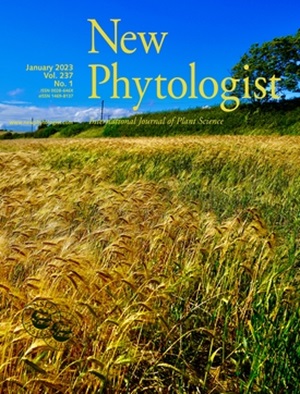Fungal guild interactions slow decomposition of boreal forest pine litter and humus.
IF 8.1
1区 生物学
Q1 PLANT SCIENCES
引用次数: 0
Abstract
Ericaceous understory shrubs and ericoid mycorrhizal fungal communities are ubiquitous in boreal forests, and their interactions with ectomycorrhizal and saprotrophic fungi may determine organic matter dynamics in forest soils. We followed decomposition of pine needle litter and mor-layer humus over 3 yr in a factorial shrub removal- and pine root exclusion experiment in an old-growth Scots pine (Pinus sylvestris) forest, to evaluate effects of fungal guilds on mass loss. Litter mass loss was 23% greater when ectomycorrhizal fungi were excluded suggesting increased saprotrophic activity, independently of ericoid shrub presence. However, this 'Gadgil effect' was only found after 17 months following a summer drought. By contrast, humus mass loss was overall stimulated by ectomycorrhizal fungi, while ericoid mycorrhizal shrubs appeared to counteract this effect, potentially caused by simultaneous addition of recalcitrant organic matter and inhibition of ectomycorrhizal decomposers. We conclude that competitive saprotrophic-ectomycorrhizal fungal interactions may slow early-stage litter decomposition, but this effect was small and inconsistent. Furthermore, interactions between ecto- and ericoid mycorrhizal guild members appear to determine the late-stage organic matter balance of boreal forest humus.真菌相互作用减缓了北方松林凋落物和腐殖质的分解。
针叶树下灌木和针叶树菌根真菌群落在北方森林中普遍存在,它们与外生菌根真菌和腐养真菌的相互作用可能决定了森林土壤的有机质动态。我们在一个古老的苏格兰松林(Pinus sylvestris)进行了一个因子清除灌木和排除松根的实验,在3年的时间里跟踪了松针凋落物和多层腐殖质的分解,以评估真菌群落对质量损失的影响。当排除外生菌根真菌时,凋落物质量损失增加23%,这表明腐坏活性增加,独立于ericoid灌木的存在。然而,这种“加吉尔效应”只在夏季干旱17个月后才被发现。相比之下,腐殖质质量损失总体上受到外生菌根真菌的刺激,而ericoid菌根灌木似乎抵消了这一影响,这可能是由于同时添加顽固性有机物和抑制外生菌根分解者造成的。我们得出结论,腐养-外生菌根真菌的竞争性相互作用可能会减缓早期凋落物的分解,但这种影响很小且不一致。此外,外生菌根和内生菌根行会成员之间的相互作用似乎决定了北方森林腐殖质后期的有机质平衡。
本文章由计算机程序翻译,如有差异,请以英文原文为准。
求助全文
约1分钟内获得全文
求助全文
来源期刊

New Phytologist
生物-植物科学
自引率
5.30%
发文量
728
期刊介绍:
New Phytologist is an international electronic journal published 24 times a year. It is owned by the New Phytologist Foundation, a non-profit-making charitable organization dedicated to promoting plant science. The journal publishes excellent, novel, rigorous, and timely research and scholarship in plant science and its applications. The articles cover topics in five sections: Physiology & Development, Environment, Interaction, Evolution, and Transformative Plant Biotechnology. These sections encompass intracellular processes, global environmental change, and encourage cross-disciplinary approaches. The journal recognizes the use of techniques from molecular and cell biology, functional genomics, modeling, and system-based approaches in plant science. Abstracting and Indexing Information for New Phytologist includes Academic Search, AgBiotech News & Information, Agroforestry Abstracts, Biochemistry & Biophysics Citation Index, Botanical Pesticides, CAB Abstracts®, Environment Index, Global Health, and Plant Breeding Abstracts, and others.
 求助内容:
求助内容: 应助结果提醒方式:
应助结果提醒方式:


